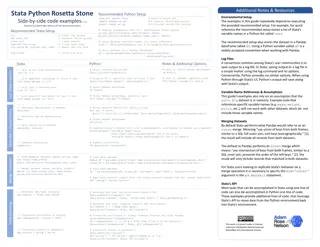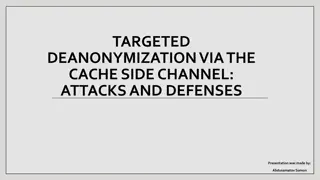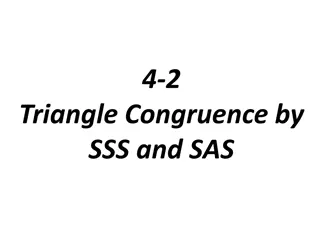
Enhancing Cyber Security: Traps, Tricks, and DNS Practices
Explore the world of cyber security with a focus on detecting scans, setting traps for hackers, hiding sensitive information, and implementing secure DNS practices. Learn about the importance of social engineering training and ways to safeguard your online presence. Dive into strategies for hiding email addresses, recognizing traps, and securing your DNS servers effectively. Stay ahead in the cyber security landscape by understanding and implementing these key practices.
Download Presentation

Please find below an Image/Link to download the presentation.
The content on the website is provided AS IS for your information and personal use only. It may not be sold, licensed, or shared on other websites without obtaining consent from the author. If you encounter any issues during the download, it is possible that the publisher has removed the file from their server.
You are allowed to download the files provided on this website for personal or commercial use, subject to the condition that they are used lawfully. All files are the property of their respective owners.
The content on the website is provided AS IS for your information and personal use only. It may not be sold, licensed, or shared on other websites without obtaining consent from the author.
E N D
Presentation Transcript
Week 4 CIS 215 THE OTHER SIDE
Detecting Scans IDS vs IPS Scripts Hacker vs legitimate user vs search engine spider Snapshots Checks of what is on the system Traps and Triggers Honeytraps and Canary https://hackernoon.com/catch-your-hacker-use-honeypot-tools-to- capture-hackers-red-handed-u71b32cr
Examples of traps Too small to read text Honeytoken - Info that seems legitimate and juicy but isn't Fake admin login info in plain text https://github.com/securewor ks/dcept White on white text Crawler traps for SEO Robots.txt to tell legit bots how to avoid traps
Example: How to hide emails on websites Image of email or @ symbol Aholdengouveia necc.mass.edu Replace mailto with script or use code to disguise the email Bonus, if you use an email only scripts/bots read it becomes a honeytrap Write out email Aholdengouveia AT necc DOT mass DOT edu CAPTCHA before email is given Contact form to request an email rather than posting the email publicly Keep in mind, anything you do that is abnormal can be difficult for accessible websites and software
Hiding Info Naming Policies Server names such as email03 easy to guess other 2 email servers Email address Are they posted online? Do they follow an obvious naming scheme? If yes, do you publish your employee list? Consider using generic emails CEO@acmecorp.com Job descriptions, do you list the products you use? Do you list your AV and networking needs in your job postings? If yes it's easy to guess your setup
Activity As pairs, discuss 1 more thing to add to how to hide info, hide email addresses, or a trap you think is valuable for a company to have set up. Be ready to share with the class
DNS Split DNS for public and private access Public should only show public facing servers Private should show ONLY what's in network Disable Zone transfers Zone transfer means you replicate the DNS database across a set of DNS servers. BIG NO NO to allow this
People Social engineering Do you have training to prevent social engineering? Are your employees aware this is a concern? Role Play to show what it looks like and how to prevent it Security procedures and policies Are you employees aware of the policies? Are they following the policies? If they aren't, why not? Is it a you problem? Or a them problem?
People cont. As a company you shouldn t use PII as authentication Mother's maiden name isn't good proof you are you Mission critical systems should have extra layers of protection Think about doing air locked systems for the most sensitive of data Do you educate your employees on what is public about them regularly? Do they google themselves? Do you have google alerts set up?
DEMO let's use SET to spoof a website In SET choose Web spoof, options 1-->2-->3 web spoof credential harvest
In depth: Phishing/Vishing/smishing Training Phishing training Show sample phishing emails Phishing email campaign with an invite for more training Spoofed email addresses Dangerous links, shortened links and attachments Vishing training for all employees with publicly search able numbers or those that interact with the public regularly (help desk, sales) Threats or coercive language The IRS will SUE YOU if you don't respond ASAP Free phone if you click here, guaranteed win! Time Pressures This sale will END in the next 3 min so click now!
Reduce your Digital footprint tips What are your employees saying about the company online? Even on private social media? What are they sharing about themselves? Do you have a policy on info sharing and IP? Are you deleting old info? Old social media? Old job postings? What has been archived(If anything)? Following breadcrumbs Are you linked to old accounts? How much public data is available about your employees? Are they aware of what's available? http://wow.intsights.com/rs/071-ZWD- 900/images/How%20to%20Reduce%20Your%20Organization %27s%20Digital%20Footprint%20%26%20Cyber%20Risk.pdf
Activity Now that you know about digital footprints. What's yours? What can you find about yourself online? What alerts do you have set up? IF you are comfortable with it, you can switch with someone and look them up. !!NOT REQUIRED OPTIONAL!! Be careful of what you find
System Hardening Ports What's open? Is that still needed? Services What's running? Is that still needed? Can you get rid of it? Any extras on the system is one more potential vulnerability for a hacker to find Patch management What is your update cycle? Patch cycle? How often do you audit your systems? Security checkups Lynis Used in Linux Admin, if you're not taking Linux Admin, try it out.
Firewalls, routing and Layers Firewalls are used to direct traffic The default options are accept, deny (drop no response) or redirect Packet inspection vs Deep packet inspection More to come during Firewall week!
Policies and Procedures Audits Frequent security audits to make sure everything is still in date and valid. For example, if you haven't had a winXP machine in 10yrs do you still need them running? Are they controlling anything? Are you keeping a running log of changes to the infrastructure and devices Device management BYOD? Are there rules such as lockers for all devices before getting on the campus? Password controls What's your password policy? What about shared passwords? Who holds master passwords? How do you backup the passwords? Who updates the backups? Hit by a bus Is your plan and backup and backup of the backup a single person? What if any one or two aren't in? Then what?






















